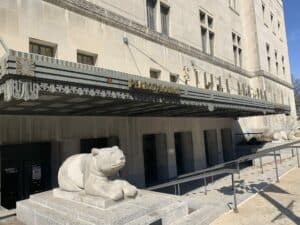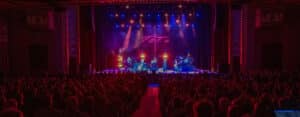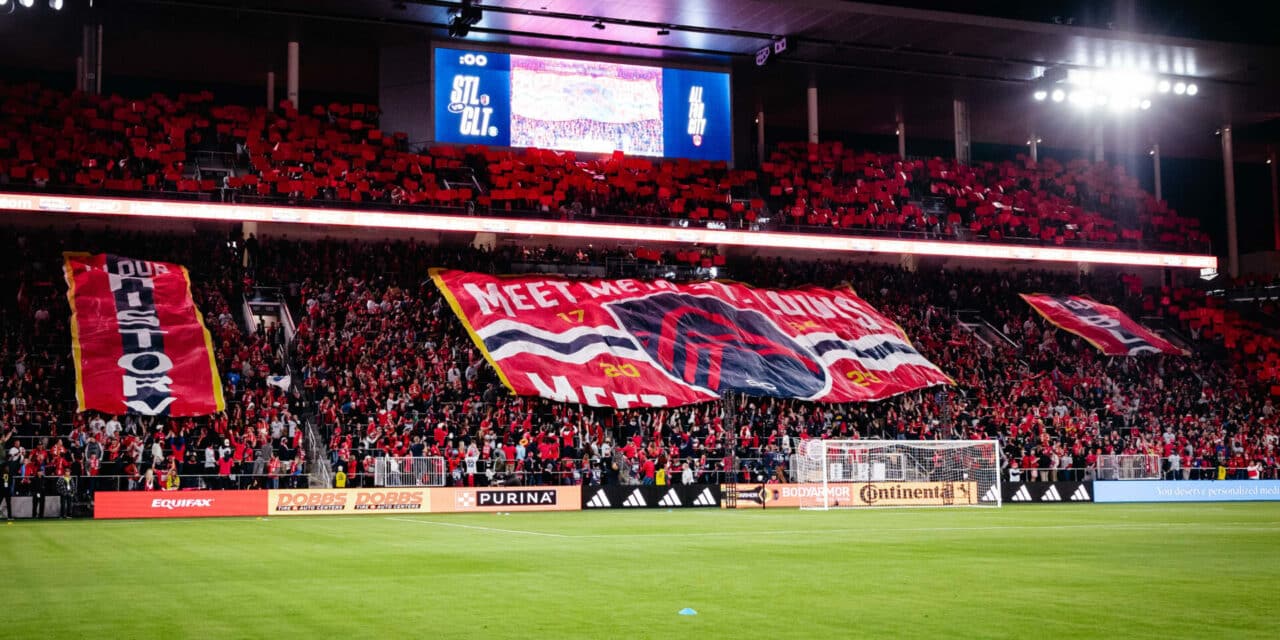MLS Takes Center Stage With CityPark
MEET ME IN ST. LOUIS: St. Louis City SC played its first home match at CityPark against Charlotte FC on March 4. (Getty Images)
HOK designed $458 million project
St. LOUIS, Missouri — In a city where baseball’s St. Louis Cardinals rule the roost, soccer has finally taken center stage at the highest level with CityPark, the new home of Major League Soccer’s St. Louis City SC.
The market has long been a hotbed of soccer but, for whatever reason, it took 20-plus years for the community to get an MLS team since the league’s first year of play in 1996. Some of the oldest soccer matches in America were played in St. Louis and the U.S. men’s national soccer team historically includes local talent on the squad.
At any one time, 50,000 kids play in youth soccer leagues in St. Louis, according to St. Louis City SC officials. Good things come to those who wait. The Taylor family, owner of Enterprise Rent-A-Car, which is based in St. Louis, took it upon themselves to acquire an expansion team and build a 22,500-seat facility that in many ways solidifies the downtown sports and entertainment corridor and serves as a catalyst for additional development in the city’s inner core.
SEE ALSO:
Factory Made in St. Louis
Centene Community Ice Center’s Concert Conversion
Blueberry Hill’s Duck Room A Shrine For Rock History, Beacon For New Talentnd-a-beacon-for-new-talent/
The $458 million project, designed by HOK, whose corporate headquarters are in St. Louis, and Snow Kreilich Architects of Minneapolis, sits on the site of an old highway off ramp, by Union Station, a historic railroad hub redeveloped into a mix of retail and restaurants. CityPark is situated about seven blocks west of Enterprise Center, home of the NHL Blues, and two miles northwest of Busch Stadium, home of MLB’s St. Louis Cardinals.
Project officials position CityPark as the next generation of MLS venues, but one that fits within the context of downtown St. Louis and historical architecture such as Union Station and the Stifel Theatre, plus the Gateway Arch, the city’s signature attraction that stands 3 miles east of the stadium along the Mississippi River.
“It’s a lot about reinforcing a new energy and reinvention in the city itself,” said Julie Snow, a design principal and CEO of the firm that bears her name. “The city is in the process of recalibrating its future. Ownership understood that it’s a soccer town and it was so important for St. Louis to go back to its roots and also bring the city together.”
The stadium stands alone in MLS as the first venue to integrate the stadium and practice facility into one complex. The decision to merge the two components came after the team dug up an old plan that showed a stadium proposed where the practice fields sit next door, to the east of CityPark.
The concept goes back to team ownership’s philosophy established early in the project for teenagers joining the parent club’s youth academy to train at the same site as the big league team, essentially becoming one holistic entity, said Chris DeVolder, HOK managing principal.
“It became clear that if we were to organize ourselves and had a little bit of time, we could move the stadium north, where it is now, and have the practice facility in the same footprint,” said Lee Broughton, St. Louis City SC’s co-owner, chief brand architect and a longtime Enterprise Rent-A-Car executive. “That’s what we proposed in our bid to MLS, a tweak made in late 2018, early 2019. It gave us the ability to put all the other stuff in place.”
All the other stuff extends to 3,300 premium seats distributed among the 28 suites and 32 pitch boxes, all of which were sold by the end of 2021, all tied to multiyear leases. All told, the team saw unprecedented demand for season tickets, generating more than 60,000 deposits. The pandemic shutdown allowed the team and Elevate Sports Ventures, their sales agency, to take a methodical approach for the six premium products without rushing through the process, officials said.
Along the way, they resisted the urge to expand stadium capacity, although the design provides the flexibility to add another 2,500 seats in future years if necessary.
“We did a lot of work to determine the right number of seats,” Broughton said. “We did not want to build a stadium that was not going to be intimate, loud and neighborly. We want great demand.”
Food and drink plays a key role in the fan experience at CityPark, with 25 local food vendors folded into Levy’s concessions operation. The team received a whopping 10,000 submissions from fans on which brands and flavors should be showcased at CityPark.
Mobile technology drives much of that piece of the equation (see From the Rafters, page 6), but the team put some ingenuity into the physical spaces themselves with dual-sided concession stands for Steve’s Hot Dogs and Balkan Treat Box. On match days, they serve fans both inside the stadium and on the exterior plaza, which is activated into a festival atmosphere with live music, games and fan giveaways. In that respect, vendors can generate revenue by catering to fans that don’t have match tickets.
“It goes back to our original intention of CityPark serving the community, the ability to run year-round and facilitate food and drink,” Broughton said. “Our underground parking garage has space for retail, and as we evolve, we can turn some of those things into pop-up stores.”
The Blues Run Enterprising Venues
ICE AGE: Enterprise Center, home of the NHL St. Louis Blues, sits next to the historic Stifel Theatre that opened in 1934. The team runs both venues. (Getty Images)
NHL Team’s Reach Extends Beyond Home Ice
The St. Louis Blues’ reach across the local sports and entertainment landscape extends beyond Enterprise Center, their home arena. They run the 18,096-seat NHL facility, plus the historic Stifel Theatre that sits next to the arena, the last remaining piece of the Municipal Auditorium complex that opened in 1934.
In addition, the Blues are an investor and a tenant at the Centene Community Ice Center, their practice facility in Maryland Heights, Missouri, a St. Louis suburb. The ice center, which opened in 2019, was designed with a fourth rink that sits outdoors and converts to a 4,000-seat amphitheater in the summer months.
On its own, the Stifel Theatre is a hidden gem and a compelling story. Ninety years ago, the initial design incorporated two separate venues attached to each other: the 3,100-seat theater and a convention hall that opened in 1936, two years after the smaller facility opened. Over the years, it evolved into a 9,300-seat auditorium.
Together, they shared a performance stage for many years. Over time, the theater, renamed the Kiel Opera House in 1943 to honor former St. Louis Mayor Henry W. Kiel, became the home of the St. Louis Symphony Orchestra and played host to a bevy of legends from Duke Ellington, Count Basie and Louis Armstrong, to Carol Channing, Katherine Hepburn, Paul Anka and Bette Midler. The roster of eclectic rock acts included Emerson, Lake and Palmer, Angel, Bob Dylan, Judas Priest, Elvis Presley and the Rolling Stones. Both Hank Williams and Hank Jr. graced the opera house stage.
In 1994, a new arena, Kiel Center, replaced the old Kiel Auditorium and became the home of the Blues after the team relocated from St. Louis Arena elsewhere in town, where they had played since joining the NHL in 1967.
As part of new arena construction, the theater closed in 1991 and remained shuttered for 20 years. It reopened as the Peabody Opera House in 2011 after a $78 million restoration. The Blues moved their administrative offices to the theater’s ground floor as part of the revitalization.
“The team kept the air conditioning working, kept the ceiling and roof water tight, and when they came in to renovate it, the place looked good,” Mitchell said. “It was not decrepit and falling apart.”
The Blues have now owned and operated the theater for the past 12 years. It was renamed in 2018 after Stifel Financial Corp., which has a jersey patch deal with the Blues, bought the venue’s naming rights for 10 years. Peabody Energy held naming rights since 2010.

STIFEL TOWERS: Venerable theater is a hidden gem and a compelling story. (Courtesy venue)
Todd Mitchell, general manager of both Enterprise Center and the Stifel Theatre, gave VenuesNow a tour of the older venue in early March. It’s a stunning mix of ornately decorated spaces, from the ticket lobby to the Budweiser Kiel Club for box seat holders and four matching ballrooms distributed equally on both sides of the building. The 225-capacity club showcases the original mirror and bar that served both of the older venues. The majestic performance hall showcases a plaster image of King Louis XIV centered above the proscenium stage.
It’s a busy place for contemporary music and the oldies. John Mellencamp, Seal, Ben Folds, Tori Amos, Zach Williams and Frankie Valli are among the upcoming shows.
“It’s a beautiful-sounding room,” Mitchell said. “The artists like it too; it’s turnkey and easy for them. We’ve got tons of space. Imagine what it would cost you to build something like this now with as much stonework and detail. It would be a fortune.”
As it stands now, things have come full circle for the 315,000-square-foot theater. The symphony, after leaving the opera house for Powell Hall in 1968, announced in February it would temporarily move its performances to the Stifel Theatre over the next 18 months while the hall undergoes a $100 million revitalization.
Separately, the Blues have a small deal with the Fox Theatre in town to hold Broadway shows at Stifel, which is also a member of the OVG Theater Alliance, a group formed to bring more events to those facilities.
“OVG brings more to the table than just shows,” Mitchell said. “They are operators of venues like ours; they are advocates for the industry on a national political level and provide an open forum for peers to discuss challenges around our industry.”
The theater’s event calendar is supported by weddings, galas and special events such as the Missouri Valley Conference’s annual Friday breakfast and Hall of Fame ceremony during “Arch Madness,” the MVC’s men’s basketball tournament that’s taken place at Enterprise Center over the past 32 years.

HOLD THE LINE: Toto played the 3,100-seat Stifel Theatre in March. (Courtesy venue)
The ballrooms alone had the flexibility to be used for practice and warm-up areas for wrestlers competing at the 2021 NCAA Division I Wrestling Championships, held at Enterprise Center, said Chris Zimmerman, the Blues’ president and CEO of business operations.
“With one entity running both buildings, we have the opportunity to leverage that (combination) in many ways,” Zimmerman said. “We do things with Blues season-ticket holders before games, pregame events and cocktail hours with our broadcasters and alumni. It’s a seamless interaction between two very different facilities.”
Most recently, the Centene Community Ice Center has become a hub for amateur hockey and ice skating competitions. The Blues are a partner in the $83.5 million facility, which is owned by the city of Maryland Heights. The ice center was privately funded by the nonprofit Legacy Ice Foundation and included $7 million in contributions from the Blues as a team and the dozen individuals that make up their ownership group.
OVG360 operates the complex, including the outdoor rink/amphitheater.
The concert operation got a late start after the ice center opened in September 2019, six months before the pandemic hit. Last year, the Saint Louis Music Park, the official name of the concert venue, hit its stride after Live Nation, which has a booking deal with the complex, held 34 shows at the flex space. The ice center sits one mile northwest of Hollywood Casino Amphitheatre, Live Nation’s 20,000-seat outdoor venue in town.
This year, as of early April, 17 dates have been confirmed, including The Flaming Lips, Walker Hayes, Ween, Darius Rucker, Mount Joy and the Goo Goo Dolls. The small amphitheater setting fits well within St. Louis, a market that does not have an outdoor concert venue of that size.
“We had a fantastic schedule last year,” Zimmerman said. “The work we did to create a strong acoustic and sound situation has been well received. We’re bullish on that piece of business. I don’t know of any other hockey practice facility that’s created a complimentary music venue. It’s a nice niche.”
Winter sports still drive a majority of content to the ice center’s indoor complex. It’s the home of Lindenwood University’s Division I men’s and women’s hockey; the St. Louis AAA Blues Hockey, an elite youth program; and the St. Louis Lady Cyclones, a girls youth hockey group. The Blues team with OVG360 and the St. Louis Sports Commission to submit bids for national competitions.
Next year, the ice center has first and second round games as part of the 2024 NCAA men’s hockey championships, and Zimmerman expects the 3,000-capacity main arena to be filled with college hockey fans. (Enterprise Center has the 2025 Frozen Four).
“I watched some regional hockey this year and I can assure you that our venue will be a lot fuller than some of those games I saw,” he said. “We’re active around attracting NCAA events and USA Figure Skating is a group that we’re in constant contact with; we hope to (be selected) for their championship.”
Apart from the NCAAs, the American Collegiate Hockey Championships return to the ice center in March 2024 after the complex played host to the 10-day event in 2022. The ACHA is a nonprofit organization tied to about 450 college club hockey teams.
Separately, the Blues submitted a proposal to host the 2025-26 World Juniors tournament at Enterprise Center, a major international event that starts in December and ends in January. If selected, Centene Community Ice Center would play a key supporting role with games and practices, Zimmerman said.
“We want to be the destination for USA Hockey,” he said. “Eighty percent of their registrants are within an eight- to 10-hour drive of St. Louis. There’s lots of value for the types of events we’re trying to bring, both local and national. We run the high school state hockey tournament at Centene. We’ve shown that we can attract crowds and drive energy in the market as well as any place.”
For Enterprise Center, after undergoing $170 million in arena-wide renovations five years ago, the Blues are picking their spots for more upgrades. They’re looking to add a second Shake Shack concession stand in the upper levels. The first one, installed last summer, is “killing it” during the first season of operation, Mitchell said.
Brett Hull’s Junction House, another new stand named for the Blues Hall of Famer, has driven higher sales as well for Levy, the arena concessionaire. Modeled after the restaurant of the same name in Wentzville, Missouri, the menu offers jumbo chicken drumsticks, fish tacos and the signature Hullie’s “Big Ass,” meatball, a 16-ounce item.
Elsewhere in the arena, Mitchell said there could be an opportunity to develop a branded sports betting lounge for mobile wagers, pending the state of Missouri legalizing the measure. The Stifel Theatre is another option, Zimmerman said. As of early April there were active sports betting bills in both the House of Representatives and the Senate.
More marketplace-style concessions and security technology is also on the horizon at Enterprise Center.
“We’re in a continuous improvement mode and looking at things that will fundamentally change our fan experience,” Zimmerman said.







